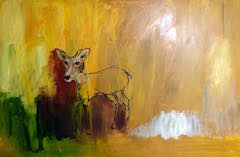Lovecraft’s circle also employed a shared mythology of entities and texts that these authors referenced across their stories. This suggested to some readers that the invented mythology had a historical basis. Novelist Kent David Kelly coined the term “imaginary sources of revelation” to describe volumes of forbidden knowledge referenced in the genre of weird fiction. The two classic examples are Lovecraft’s Necronomicon and the play “The King in Yellow,” with its fictional setting in a city called Carcosa, referenced throughout the stories of Robert Chambers. References to Carcosa and the Yellow King in True Detective starting in episode 1.3 signal that Pizzolatto is invoking the same shared mythology as the Weird Tales authors.
Cryptic references to these texts have obsessed readers into the present day. Lovecraft’s letters describe how even in his own lifetime, some readers had come to believe that the dark powers he described were real. In 1970, Lovecraft’s story “The Dunwich Horror” was adapted into a film of the same name. The story and film featured the Necronomicon, a forbidden book that summoned malevolent extra-dimensional beings. Not long after the release of the film, some moral entrepreneurs began to insist that the Necronomicon is a real book used by Satanic cults. In 1988, the group Bothered About Dungeons and Dragons distributed a guide to police for interrogating suspected teenage occultists. One of the questions was “Have you ever read the Necronomicon?” This strange trajectory of the Necronomicon demonstrates how fictional mythologies can bleed into modern folklore and finally into moral panic.
A second wave of satanic pop culture occurred forty years later with the “demonic trilogy” of Rosemary’s Baby (1968), The Exorcist (1974), and The Omen (1976). Scholars such as David Bromley and David Frankfurter have suggested that cultural changes in the 1970s and 1980s created a demand for a discourse of evil that could articulate fears and frustrations while presenting complex social problems as facets of a unified – and therefore manageable – conspiracy. Hollywood helped America to imagine what this conspiracy looked like. Even though these films were fiction, they “revealed” what audiences suspected to be true. Recovered memories of Satanic abuse, questions asked by cult cop interrogators, and descriptions of Satanism from TV talk show hosts all borrowed tropes from horror movies. These connections allowed pop culture to further shape the folklore surrounding Satanic cults.
Bait and Switch
Watching season one of True Detective I felt that the stark shift from cosmic horror to eucatastrophe worked to both conceal and strengthen the story’s Manichaean worldview. The first seven episodes of the show hint that the story is building up to a moment of cosmic horror. The series opens with a murder scene littered with paraphernalia that is ritualistic, but not Satanic: spirals not pentagrams, antlers not black candles. Nevertheless, the sheriff states confidently, “The symbols, they’re Satanic. They had a 20/20 on it a few years back.” The comment appears to cue the audience that they are more savvy about such claims than this sheriff or the yellow journalists at 20/20. Later, a forensic scientist explains that the symbols are “all primitive, like cave paintings” and advises the investigators to consult an anthropologist. In the second episode, we meet Reverend Billy Lee Tuttle who wants a special task force to take over the investigation because of the murder’s “anti-Christian connotation.” He adds, “There is a war behind this,” invoking the historical link between a theology of spiritual warfare and Satanic Panic. We later learn that Tuttle is himself part of the conspiracy. Thus the first two episodes hint at a cult that not only predates Christianity and its counter-mythology of Satanism, but also has learned to use Satanic Panic to mask its own activities. Combined with the use of tropes from Robert Chambers’s stories, these early clues led me to assume the story was building to a revelation that would render the mythology of Satanic Panic irrelevant.



